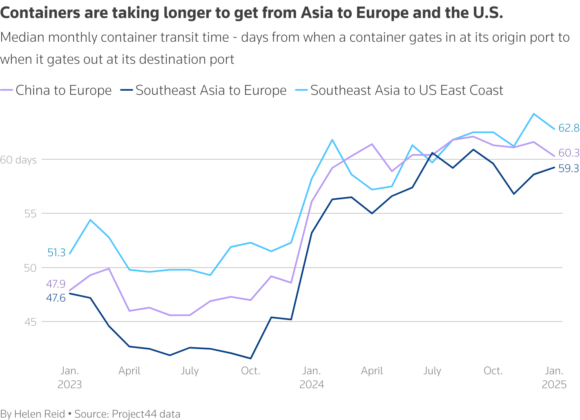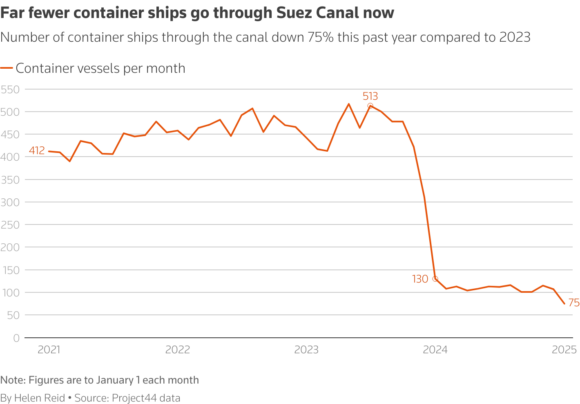Companies transporting their products around the world are not ready to return to the Red Sea trade route in the wake of a Gaza ceasefire deal because of uncertainty over whether Yemen’s Houthis will continue to attack shipping, industry executives said.
The leader of Yemen’s Houthis said on Thursday that the Iran-aligned group would monitor the implementation of a ceasefire deal between Israel and Hamas aimed at ending the war in Gaza and continue its attacks on vessels or Israel if it is breached.
The Houthi militia has carried out more than 100 attacks on ships since November 2023 and has sunk two vessels, seized another and killed at least four seafarers in what they say is solidarity with Palestinians in Gaza.
Maritime Sources Expect Houthis to Halt Red Sea Attacks After Gaza Deal
The intensity of the attacks has disrupted global shipping and prompted route changes.
Executives from shipping, insurance and retail industries told Reuters the risks remained too high to resume voyages through the Bab al-Mandab strait in the Red Sea through which exports to Western markets from the Gulf and Asia must pass before entering the Suez Canal.
“There is no way I’m putting any of my merchandise on a boat that’s going to go through the Red Sea for some time to come,” said Jay Foreman, CEO of U.S.-based Basic Fun, which supplies toys to major U.S. retailers like Walmart and Amazon.com.
“I’ll spend the extra money, and I’ll send everything around the tip of Africa… It’s just not worth taking a chance.”
Trial Runs
Matt Castle, vice president of global forwarding with logistics group C.H. Robinson, said: “It’s not likely the industry will see a large shift back to the Suez Canal in the short term.”
He said this was due to the challenges related to securing cargo insurance given perceived high risks and time constraints, as it would take weeks or months to implement a new ocean shipping plan.
If the Houthis do halt the attacks, retailers may have to wait until the second quarter for shipping lines to fully shift their routes, said Craig Poole, managing director at Cardinal Global Logistics, whose clients include B&M Retail and Pets At Home.
“It’ll definitely be a case of trialing the route, making sure that the ceasefire is genuine.”
Maritime security sources said companies would treat any pledge by the Houthis to halt attacks with caution and would opt for test voyages to assess the risk environment.
For larger ships, such as tankers carrying liquefied natural gas, any resumption would take longer due to bigger risks if such a ship carrying a flammable cargo was hit.
Norwegian shipper Wallenius Wilhelmsen, which transports vehicles by ship, said it would not resume sailing through the Red Sea “until it is safe.”


Swedish fashion retailer H&M, which uses sea freight to transport most of its products from factories in Asia to Europe, said it was monitoring the situation.
Tailwind Shipping Lines, a shipping firm owned by German supermarket chain Lidl, said the security of crew, ships and cargo was a top priority.
The European Union’s naval force in the Red Sea said its “threat assessment remains unchanged.”
War Risks
Higher war risk insurance premiums, paid when vessels sail through the Red Sea, have meant additional costs of hundreds of thousands of dollars for a seven-day voyage for any ships still sailing through the area.
Insurance sources said on Friday that additional war risk premiums were quoted between 0.6% and up to 2% of the value of the vessel if a ship had any links to Israel or the U.S. and were broadly unchanged in recent months.
(Reporting by Jonathan Saul, Helen Reid and Carolyn Cohn in London, Renee Maltezou in Athens, Lisa Baertlein in Los Angeles and Agnieszka Olenska in Gdansk. Editing by Jane Merriman)
Photograph: This undated photo released by the private security firm Ambrey shows the oil tanker Sounion in the Red Sea. (Ambrey via AP)
The most important insurance news,in your inbox every business day.
Get the insurance industry’s trusted newsletter
